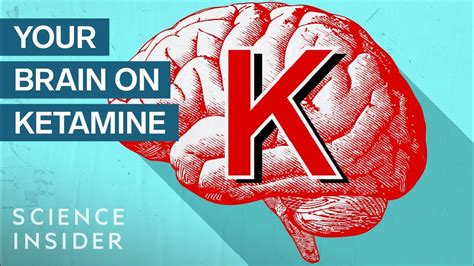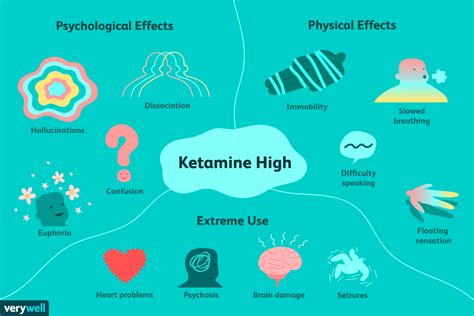What Does Ketamine Do To The Brain

Unraveling the Impact: Ketamine's Effect on the Brain

Ketamine, a substance with a multifaceted nature, has been a topic of intrigue and research within the medical and neuroscience communities for decades. This article aims to delve into the intricate effects that ketamine has on the brain, exploring its mechanisms, potential therapeutic applications, and the associated risks.
Known primarily as an anesthetic and recreational drug, ketamine has gained significant attention for its unique ability to induce dissociative states and alter cognitive function. While its impact on the brain is complex and multifaceted, ongoing research provides valuable insights into its potential benefits and risks.
The Neurochemical Profile: How Ketamine Affects Brain Chemistry

Ketamine's primary mode of action involves its interaction with specific receptors in the brain, primarily the N-methyl-D-aspartate (NMDA) glutamate receptors. These receptors play a crucial role in neurotransmission, memory, and learning processes. By blocking these receptors, ketamine induces a range of effects, from analgesia (pain relief) to dissociative states.
One of the key neurochemical changes induced by ketamine is the increase in glutamate release. Glutamate is the brain's primary excitatory neurotransmitter, and its elevation can lead to various effects, including altered sensory perception and cognitive function. Additionally, ketamine influences other neurotransmitter systems, such as dopamine and serotonin, contributing to its complex psychological and physiological impacts.
The Role of Glutamate in Ketamine's Effects
Glutamate, often referred to as the brain's 'excitatory' neurotransmitter, plays a central role in ketamine's mechanism of action. By blocking NMDA receptors, ketamine causes a buildup of glutamate, which in turn activates other receptors, leading to a cascade of effects. This glutamate surge is believed to be responsible for the unique dissociative and hallucinogenic properties associated with ketamine use.
Furthermore, the increased glutamate activity can also lead to neuroplastic changes in the brain. Neuroplasticity refers to the brain's ability to adapt and reorganize itself, and ketamine's impact on this process is a subject of intense interest within the field of neuroscience. Researchers are exploring how these neuroplastic changes might contribute to both the therapeutic benefits and potential long-term risks of ketamine use.
Therapeutic Potential: Ketamine as a Revolutionary Treatment
Despite its recreational use and associated risks, ketamine has emerged as a promising therapeutic agent for various mental health conditions. Its unique mechanism of action offers a fresh perspective on treating disorders that have traditionally been challenging to manage effectively.
Ketamine for Depression and Anxiety Disorders
One of the most groundbreaking applications of ketamine is in the treatment of depression. Clinical trials have shown that low doses of ketamine can rapidly reduce symptoms of depression, even in individuals who have not responded to traditional antidepressant medications. This rapid-acting effect is a significant advantage, offering hope to those suffering from severe and treatment-resistant depression.
Furthermore, ketamine's ability to induce a dissociative state has been explored as a potential treatment for post-traumatic stress disorder (PTSD) and anxiety disorders. By temporarily altering the individual's perception of their surroundings, ketamine may provide a therapeutic window to process traumatic memories and reduce anxiety symptoms. However, the precise mechanisms underlying these therapeutic effects are still being unraveled.
Pain Management and Chronic Pain Conditions
Ketamine's analgesic properties have long been utilized in medical settings, particularly in emergency and intensive care situations. Its ability to provide pain relief while maintaining cardiovascular stability makes it a valuable tool in acute pain management. Additionally, researchers are exploring its potential in managing chronic pain conditions, such as neuropathic pain and complex regional pain syndrome.
One notable aspect of ketamine's analgesic effect is its ability to modulate pain perception at various levels of the nervous system. This multi-level action may offer unique advantages in managing pain that is resistant to traditional opioid-based treatments. However, the long-term use of ketamine for pain management is still an area of active research and clinical exploration.
Potential Risks and Adverse Effects
While ketamine's therapeutic potential is undeniable, it is essential to acknowledge the potential risks and adverse effects associated with its use. These risks are particularly relevant in recreational settings, where ketamine is often used without medical supervision or knowledge of its proper administration.
Psychological Risks and Dependency
Ketamine's dissociative and hallucinogenic properties can lead to a range of psychological effects, both short-term and long-term. Short-term effects may include confusion, anxiety, and impaired judgment, while long-term use has been associated with cognitive impairments, memory problems, and even psychotic-like symptoms in some individuals.
Furthermore, the recreational use of ketamine carries a risk of dependency and addiction. Regular use can lead to tolerance, requiring higher doses to achieve the desired effects. This tolerance can quickly spiral into dependence, with individuals experiencing withdrawal symptoms when ketamine use is reduced or stopped.
Physical Risks and Side Effects
In addition to psychological risks, ketamine use is associated with various physical side effects. These can include increased heart rate and blood pressure, nausea, blurred vision, and in some cases, respiratory depression. Prolonged or excessive use may also lead to bladder and kidney problems, as ketamine can have toxic effects on these organs.
One of the most severe physical risks associated with ketamine use is the potential for accidental injury or harm during the dissociative state. Individuals under the influence of ketamine may exhibit impaired coordination, increased risk-taking behaviors, and a reduced awareness of their surroundings, leading to potentially dangerous situations.
| Therapeutic Applications | Potential Risks |
|---|---|
| Depression, Anxiety Disorders | Psychological dependency, cognitive impairments |
| Pain Management | Physical side effects, tolerance, addiction |
| PTSD Treatment | Psychological risks, dissociative states |

Conclusion: Navigating the Complex Landscape of Ketamine's Effects

Ketamine's influence on the brain is a multifaceted journey, with its impact ranging from therapeutic breakthroughs to potential health risks. Understanding this substance's intricate mechanisms is crucial for harnessing its benefits while minimizing harm.
As research continues to unravel the mysteries of ketamine's effects, the medical community must strike a delicate balance between embracing its therapeutic potential and addressing its associated risks. With proper medical supervision and ongoing research, ketamine may offer new hope for those struggling with treatment-resistant mental health conditions and chronic pain. However, the recreational use of ketamine remains a significant concern, underscoring the importance of public education and awareness.
In conclusion, the story of ketamine's effect on the brain is a testament to the complexity of neuroscience and the potential for innovative treatments. It serves as a reminder that every substance, whether therapeutic or recreational, carries a unique set of risks and benefits that require careful consideration and ongoing exploration.
What is ketamine’s mechanism of action in the brain?
+
Ketamine primarily acts by blocking NMDA glutamate receptors, leading to an increase in glutamate release and activation of other receptors, resulting in various effects such as analgesia and dissociative states.
How does ketamine impact neuroplasticity?
+
Ketamine’s influence on glutamate levels can lead to neuroplastic changes in the brain. These changes are being explored for their potential role in both therapeutic benefits and long-term risks.
What are the potential therapeutic applications of ketamine?
+
Ketamine shows promise in treating depression, anxiety disorders, and chronic pain conditions. Its rapid-acting antidepressant effects and unique mechanism of action offer new hope for treatment-resistant cases.
What are the risks associated with ketamine use?
+
Risks include psychological dependency, cognitive impairments, physical side effects, and the potential for accidental injury during dissociative states. Regular use can lead to tolerance and addiction.
How can we ensure the safe use of ketamine for therapeutic purposes?
+
Medical supervision, responsible dosing, and ongoing research are crucial to mitigate risks and maximize the benefits of ketamine therapy. Public education and awareness are also essential to prevent recreational misuse.



